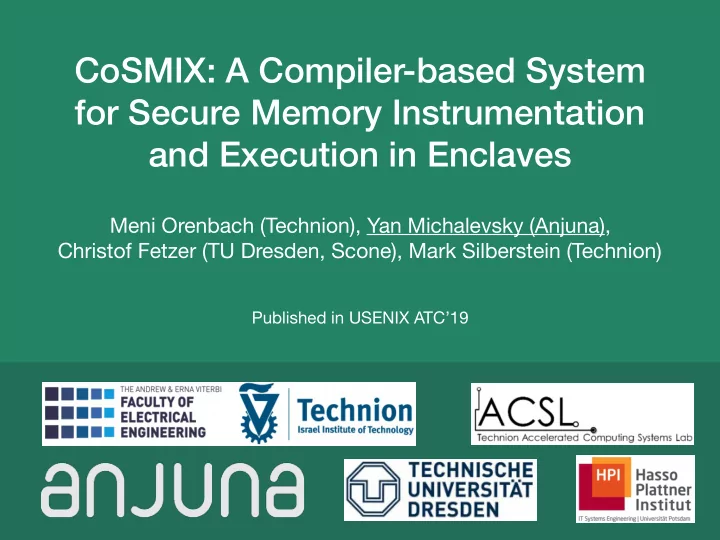

CoSMIX: A Compiler-based System for Secure Memory Instrumentation and Execution in Enclaves Meni Orenbach (Technion), Yan Michalevsky (Anjuna), Christof Fetzer (TU Dresden, Scone), Mark Silberstein (Technion) Published in USENIX ATC’19
Speaker bio • Yan Michalevsky • Co-founder and CTO of Anjuna Security (www.anjuna.io) • Phd from Stanford University (applied security and cryptography) • B.Sc from Technion (EE) • Speaker at BlackHat, RSA Conference • Research featured in BBC, Wired, Engadget, ArsTechnica and more
Enclaves Enclave • Confidentiality • Integrity • Assume an untrusted operating system • Recent advancements in OS Library OS and unikernel- based approaches enable execution of entire applications
Motivation: missing OS abstractions, performance and side-channel protection • Features • Memory-mapping • Performance • Secure User-managed Virtual Memory (SUVM) [Orenbach et al. ’17 (Eleos)] • Side-channel protection • Transparent Oblivious RAM for enclaved applications protects against controlled side-channel attacks • And much more (custom memory backends…)
Memory-mapping: missing construct in enclaves
Page-fault handling with SGX 6x the latency of signal handling without SGX
Prior work • Sidestep the lack of secure page faults by customizing applications • Eleos (SUVM) [Orenbach et al. ’17] • ZeroTrace (ORAM) [Sasy et al. ’18] • Require specialized handling of memory accesses • Reference implementations are language-specific • Eleos implementation is not suitable for high-level languages
CoSMIX • Compiler + runtime • Automatic and transparent customization of memory accesses and page-fault handling • Automatic inference of pointer types via pointer-analysis • Locality-optimized translation caching • Selective instrumentation of memory accesses • Guided by annotations of memory allocation • Automatic inference of related memory accesses
Memory Store (mStore) • mStore — a software abstraction of memory access behavior • An additional virtual memory layer on top of a backing store • Handles • Allocation • Deallocation mStore Backing-store address address • Address translation • Paging
Direct-access memory store
Cached memory store
Use-case: Secure User-managed Virtual Memory (SUVM) • Proposed by Orenbach et al. ’17 (Eleos) • Motivation: avoid costly enclave transitions to handle demand paging • Provides the same confidentiality and integrity guarantees as the EPC • Caches pages in the EPC • Can boost performance by ~2x compared to regular execution in SGX
Use case: Oblivious RAM (ORAM) Controlled side-channel attacks can recover quite a bit of information by examining memory access patterns [Xu et al. 2015]
Use case: Oblivious RAM (ORAM) • Preserves I/O behavior • Obfuscates memory access patterns
CoSMIX end-to-end
CoSMIX end-to-end Annotate memory allocations with memory stores to use
CoSMIX end-to-end Annotate Proper memory access memory instrumentation is allocations inferred based on with memory allocation annotations stores to use
Stacking mStore-s ORAM SUVM SUVM ORAM
Evaluation Workloads Fetching a 4 KB page
Memcached 600 MB dataset Random access to 1KB objects. 90% get / 10% set
Memcached 600 MB dataset Random access to 1KB objects. 90% get / 10% set
ORAM SUVM
Summary • Compiler-based approach to memory instrumentation and SW page-fault handling • Conveniently addresses • Lacking functionality • Performance • Security against certain side-channels • Extensible
Thank You. Questions? www.anjuna.io yan@anjuna.io � 22
Recommend
More recommend